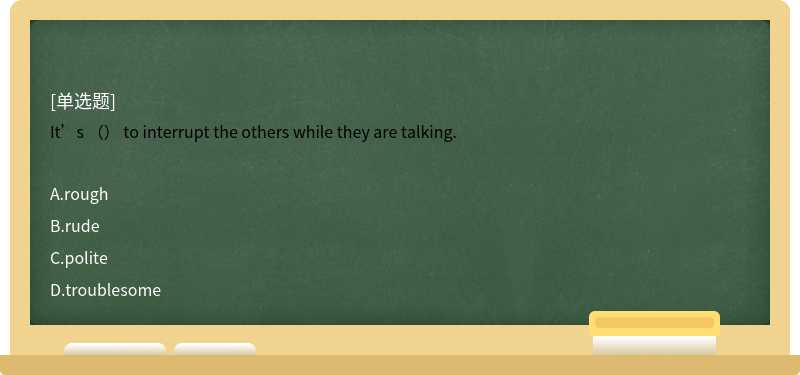 题目内容
(请给出正确答案)
题目内容
(请给出正确答案)


It’s () to interrupt the others while they are talking.
A、rough
B、rude
C、polite
D、troublesome

 题目内容
(请给出正确答案)
题目内容
(请给出正确答案)


A、rough
B、rude
C、polite
D、troublesome

 更多“It’s () to interrupt the…”相关的问题
更多“It’s () to interrupt the…”相关的问题
Reading Comprehension 阅读理解
从下列每篇短文的问题后所给的四个选择项中选出一个最佳答案。
Let's look at another example of how people's communication patterns differ: the way people converse. Some foreigners have observed that when Americans carry on a conversation, it seems as if they are having a Ping-Pong game. One person has the ball and then hits it to the other side of the table. The other player hits the ball back and the game continues. If one person doesn't return the ball, then the conversation stops. Each part of the conversation follows this pattern: the greeting and the opening, the discussion of a topic, and the closing and farewell. If either person talks too much, the other may become impatient and feel that he is dominating the conversation. Similarly, if one person doesn't say enough or ask enough questions to keep the conversation going, the conversation stops.
Many North Americans, are impatient with culturally different conversation styles simply because the styles are unfamiliar. For example, to many North Americans it seems that some Latin Americans dominate conversations, or hold the ball too long. Speaking of her co-workers from several Latin American countries, one North American woman said, “I just find it difficult to cut in. They seem to take such a long time to express themselves. They give you a lot of unnecessary details.” When she talked with them, she became tense, because she found it so hard to participate. Yet she also noted that when they talked to each other, nobody seemed uncomfortable or left out.
The North American woman didn't know how to interrupt the Latin American conversations because North American ways of listening and breaking in are very different. She had been taught to listen politely until the other person finished talking. (Once again, there are gender (性别) differences; it has been observed that men tend to interrupt women more than women interrupt men. )When the North American woman did what was “natural” or “normal” for her (i. e. , listen politely without interrupting), she was not comfortable in the conversation with the Latin Americans. The result was that she became more passive in her conversations with her co-workers. The differences between the unspoken rules of conversation of each cultural group interfered with their on-the-job relationship.
26、When North Americans converse together, each one of the group is supposed to_______________.
A.participate in the talk
B.play Ping-Pong games
C.interrupt the speaker
D.dominate the conversation
27、When North Americans converse with the Latin Americans, the North Americans would feel_______________.
A.involved
B.left out
C.comfortable
D.relaxed
28、To the North Americans, the Latin Americans are_______________.
A.polite
B.communicative
C.dominant
D.familiar
29、We can infer from this passage that_______________.
A.people from different cultures cannot communicate with each other
B.different conversational styles may affect people's relationships
C.men are more talkative than women
D.North Americans' conversational habits are better than those of Latin Americans'
30、The best title for this passage is_______________.
A.Different Conversation Styles
B.Different Conversation Topics
C.Different Conversation Processes
D.Different Conversation Effects
A、共享外设中断(Shared Peripheral Interrupt,SPI)
B、私有外设中断(Private Peripheral Interrupt,PPI)
C、软件产生的中断(Sqftware Generated Interrupt,SGI)
D、特定位置外设中断(Locality-specific Peripheral Interrupt,LPI)
A、safety interlock switch
B、scan interrupt
C、safety interlock
D、safety interlock switch key